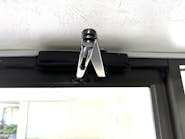Von Duprin Concealed Vertical Cable System Reduces Installation Time and Maintenance
Concealed vertical rod exit devices are aesthetically pleasing. Architects love to specify these devices, as they are "clean," with only the bar visible. Door manufacturers offer recessed configurations for the concealed vertical rod exit devices, exposing even less of the bar. There are no visible rods or latches with a concealed vertical rod exit device, and there are no Pullman bolts extending from the center case or strikes mounted onto the jamb.
For double-door entries, the vertical rod exit device is the only alternative to a mullion and rim devices, which is aesthetically unappealing. For many hospitals and universities, the mullion is not an alternative. Large carts and gurneys need more width than a single door opening. Codes require a door to close and latch. Thus, at least one vertical rod exit device is needed for double door entries that are not equipped with a mullion.
Concealed vertical rod exit device mechanisms are more sensitive to abuse. This is especially true when the doors are repeatedly hit by carts, heavily loaded hand trucks or forklifts that "tweak" the mechanisms. Too much pressure against the latched door will result in problems.
Although not a solution, some openings can be equipped with a "Top Rod Only" vertical exit device, eliminating the bottom rod, latch and strike plate. Top rod only should be used in applications such as interior doors where you do not want people tripping on the bottom strike plate. The top rod only configuration does not help with vehicles or abuse, but it helps to eliminate the lesser problems that occur when the floor-mounted strike opening becomes clogged with debris or the cleaning crew seems to use way too much wax or cleaning fluids.
These situations can result in the latches not being fully extended. In these cases, neither the top nor bottom latches are securing the door. An out-of -position vertical rod exit device is not a good thing. These problems and others can cause a vertical rod exit devices to come out of adjustment relatively easily.
To solve some of these problems, Von Duprin has developed the Concealed Vertical Cable Systems for fire rated and non-fire rated openings, the 98/9949 Series and the 33A/35A49 Series. The cable-actuated system has been tested to meet ANSI/BHMA A156.3 Grade 1, NFPA 101, NFPA 5000, NFPA 80, IBC, NBCC, FBC, ADA, Nec Class2 and is UL listed for Panic Exit and/or Fire Exit Hardware. According to Von Duprin, the product cycle life shall exceed 1,000,000 cycles. Non fire-rated exit devices have dogging capability.
The Von Duprin stainless steel core wire cable system replaces the top and bottom vertical rods, providing a different path for retraction. When the trim retracts or the push pad is pressed, a cable goes from the center case to the top latch mechanism and releases it from the strike. At the same time, a second cable running from the top latch mechanism to the bottom latch mechanism retracts the bottom latch, permitting the door to be opened. This configuration eliminates the run from the center case to the bottom latch. This lack of direct connection should eliminate many of the problems when the bottom latch cannot be secured within the floor strike opening.
The enclosed cable system attaches to the exit device with a single setscrew. Core wire ends snap into the latch mechanisms and center slide. According to Von Duprin, the sinter latches have improved deadlocking mechanisms.
The top latch is new, a "U" shaped, tilting top latch mechanism. When in the locked position, the "U" shaped latch is vertical. To release the door, the top latch tilts in towards the jamb, permitting the door to swing open. The top strike has a tab that the latch encompasses. The latch release does not require a separate trigger mechanism.
The bottom latch is "L" shaped with the tip tilting into the strike opening. Unlike the Pullman latch style used on the vertical rod mechanisms.
The latches are adjustable with the door mounted. The bottom latch position can be adjusted within two inches without any modifications required.
The cables are ordered according to the height of the door:
Door Height Range
Feet Inches Low High
6’8” 80” 7’9” 80.5”
7’ 8’4” 83” 84.5”
8’ 96” 95” 96.5”
9’ 108” 107” 108.5”
10” 120” 119” 120.5”
Von Duprin designed this cable exit device with the ability to move the bottom latch two inches in order to compensate for the different conditions that affect a door. To gain access to the bottom latch, an access hole is drilled into the lock edge of the door at approximately 3-1/4" above the bottom of the door. Behind a snap-on cap, an attached pin keeps the bottom latch mounting bracket and bottom latch in position. The pin can be removed, permitting the bottom latch to be raised or lowered to align at the bottom of the door.
For more information, contact your local locksmith distributor or www.securitytechnologies.ingersollrand.com.






